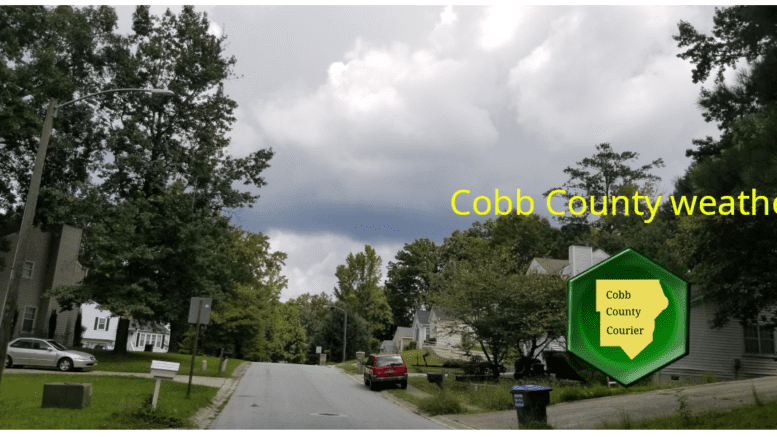The National Weather Service forecasts showers and possibly a thunderstorm here in Cobb County on Sunday, April 21, 2024, with a high near 60 degrees.
The National Weather Service has issued a hazardous weather outlook for Cobb County and other parts of the region due to few thunderstorms that are possible across the southern part of the area, mainly this morning near and south of a Columbus to Macon line.
What does the extended forecast have in store?
This forecast is centered on Dobbins Air Reserve Base in Marietta.
Sunday
Showers and possibly a thunderstorm before 1 p.m, then a chance of showers. Patchy fog between 9 a.m and 11 a.m. High near 60. Northwest wind around 10 mph, with gusts as high as 15 mph. Chance of precipitation is 80 percent. New precipitation amounts between a quarter and half of an inch possible.
Sunday Night
Partly cloudy, with a low around 42. Northwest wind around 10 mph, with gusts as high as 15 mph.
Monday
Sunny, with a high near 66. Northwest wind around 5 mph.
Monday Night
Clear, with a low around 42. Northwest wind around 5 mph becoming calm in the evening.
Tuesday
Sunny, with a high near 73.
Tuesday Night
Mostly clear, with a low around 50.
Wednesday
Sunny, with a high near 75.
Wednesday Night
Mostly clear, with a low around 49.
Thursday
Sunny, with a high near 76.
Thursday Night
Partly cloudy, with a low around 54.
Friday
Mostly sunny, with a high near 78.
Friday Night
Mostly cloudy, with a low around 60.
Saturday
Partly sunny, with a high near 78.
What was the climate like in the latest reporting period?
The NWS climate summary for metro Atlanta has now been updated with February 2024 figures.
In an article entitled What is the Difference between Climate and Weather?, the National Ocean Service describes the difference as follows:
“Weather is what you see outside on any particular day. So, for example, it may be 75° degrees and sunny or it could be 20° degrees with heavy snow. That’s the weather.
“Climate is the average of that weather. For example, you can expect snow in the Northeast in January or for it to be hot and humid in the Southeast in July. This is climate. The climate record also includes extreme values such as record high temperatures or record amounts of rainfall. If you’ve ever heard your local weather person say “today we hit a record high for this day,” she is talking about climate records.
“So when we are talking about climate change, we are talking about changes in long-term averages of daily weather. In most places, weather can change from minute-to-minute, hour-to-hour, day-to-day, and season-to-season. Climate, however, is the average of weather over time and space.”
The climate report for the Atlanta area for the previous month shows how much departure from the average temperatures that month represents. The average temperature for a date is the average over a 30-year period.
| Date | High | Low | Average | Departure from norm | Precipitation |
| 2024-03-01 | 49 | 40 | 44.5 | -7.4 | 1.11 |
| 2024-03-02 | 62 | 42 | 52 | -0.2 | T |
| 2024-03-03 | 70 | 49 | 59.5 | 7.1 | 0 |
| 2024-03-04 | 63 | 57 | 60 | 7.3 | T |
| 2024-03-05 | 61 | 55 | 58 | 5.1 | 1.02 |
| 2024-03-06 | 65 | 56 | 60.5 | 7.3 | 2.36 |
| 2024-03-07 | 76 | 53 | 64.5 | 11.1 | 0 |
| 2024-03-08 | 66 | 59 | 62.5 | 8.8 | 1.45 |
| 2024-03-09 | 69 | 52 | 60.5 | 6.6 | 0.65 |
| 2024-03-10 | 61 | 43 | 52 | -2.2 | 0 |
| 2024-03-11 | 67 | 38 | 52.5 | -1.9 | 0 |
| 2024-03-12 | 74 | 44 | 59 | 4.4 | 0 |
| 2024-03-13 | 75 | 47 | 61 | 6.1 | 0 |
| 2024-03-14 | 81 | 52 | 66.5 | 11.4 | 0 |
| 2024-03-15 | 72 | 61 | 66.5 | 11.1 | 0.36 |
| 2024-03-16 | 75 | 57 | 66 | 10.4 | 0 |
| 2024-03-17 | 67 | 53 | 60 | 4.1 | 0.02 |
| 2024-03-18 | 61 | 40 | 50.5 | -5.6 | 0 |
| 2024-03-19 | 60 | 33 | 46.5 | -9.8 | 0 |
| 2024-03-20 | 74 | 42 | 58 | 1.4 | 0 |
| 2024-03-21 | 77 | 51 | 64 | 7.2 | 0 |
| 2024-03-22 | 65 | 56 | 60.5 | 3.4 | 0.25 |
| 2024-03-23 | 69 | 50 | 59.5 | 2.2 | 0.04 |
| 2024-03-24 | 65 | 43 | 54 | -3.5 | 0 |
| 2024-03-25 | 64 | 47 | 55.5 | -2.3 | 0 |
| 2024-03-26 | 62 | 53 | 57.5 | -0.5 | 0.72 |
| 2024-03-27 | 74 | 53 | 63.5 | 5.2 | T |
| 2024-03-28 | 68 | 50 | 59 | 0.5 | 0 |
| 2024-03-29 | 72 | 43 | 57.5 | -1.2 | 0 |
| 2024-03-30 | 77 | 49 | 63 | 4 | 0 |
| 2024-03-31 | 80 | 56 | 68 | 8.8 | 0 |
Climate Almanac for metro Atlanta
This almanac provides information on past climate conditions for today’s date, April 21, allowing a comparison to current weather.
Simply put, it helps you see what the weather would typically be like on this day, according to historical data.
| Daily Data | Observed | Normal | Record Highest | Record Lowest |
| Max Temperature | M | 75 | 88 in 1987 | 45 in 1901 |
| Min Temperature | M | 54 | 68 in 1915 | 33 in 1953 |
| Avg Temperature | M | 64.6 | 76.5 in 2002 | 41.0 in 1901 |
| Precipitation | M | 0.12 | 0.95 in 1995 | 0.00 in 2023 |
| Snowfall | M | 0.0 | 0.0 in 2023 | 0.0 in 2023 |
| Snow Depth | M | – | 0 in 2023 | 0 in 2023 |
| HDD (base 65) | M | 3 | 24 in 1901 | 0 in 2023 |
| CDD (base 65) | M | 2 | 12 in 2002 | 0 in 2021 |
| Month-to-Date Summary | Observed | Normal | Record Highest | Record Lowest |
| Avg Max Temperature | 75.8 | 72.7 | 79.0 in 1967 | 60.0 in 1901 |
| Avg Min Temperature | 55.2 | 51.3 | 58.1 in 2015 | 41.1 in 1907 |
| Avg Temperature | 65.5 | 62.0 | 67.3 in 1967 | 50.5 in 1907 |
| Total Precipitation | 5.15 | 2.69 | 9.50 in 1979 | 0.11 in 1976 |
| Total Snowfall | 0.0 | 0.0 | T in 2022 | 0.0 in 2024 |
| Max Snow Depth | 0 | – | 0 in 2024 | 0 in 2024 |
| Total HDD (base 65) | 54 | 99 | 297 in 1907 | 12 in 1967 |
| Total CDD (base 65) | 69 | 36 | 83 in 2017 | 0 in 1984 |
| Year-to-Date Summary | Observed | Normal | Record Highest | Record Lowest |
| Avg Max Temperature | 64.3 | 61.9 | 67.5 in 2017 | 53.5 in 1895 |
| Avg Min Temperature | 44.6 | 42.1 | 47.5 in 2023 | 34.1 in 1940 |
| Avg Temperature | 54.5 | 52.0 | 57.5 in 2017 | 43.9 in 1940 |
| Total Precipitation | 23.45 | 16.51 | 32.81 in 1936 | 7.95 in 1986 |
| Total Snowfall (since July 1) | T | 2.2 | 10.9 in 1936 | 0.0 in 2019 |
| Max Snow Depth (since July 1) | 0 | – | 8 in 1940 | 0 in 2024 |
| Total HDD (since July 1) | 2015 | 2500 | 3785 in 1977 | 1656 in 2017 |
| Total CDD (since Jan 1) | 79 | 54 | 156 in 2012 | 1 in 1962 |
Period of Record:
- Max Temperature : 1878-10-04 to 2024-04-20
- Min Temperature : 1878-10-04 to 2024-04-20
- Precipitation : 1878-10-01 to 2024-04-20
- Snowfall : 1928-12-25 to 2024-04-20
- Snow Depth : 1928-12-25 to 2024-04-20
For much more information on the climate in our area, visit the NWS Climate FAQ for the Atlanta area.
What does the National Weather Service do?
The National Weather Service (NWS) is a part of the National Oceanic and Atmospheric Administration (NOAA).
The NWS describes its role as follows:
“The National Weather Service (NWS) provides weather, water, and climate forecasts and warnings for the United States, its territories, adjacent waters and ocean areas, for the protection of life and property and the enhancement of the national economy.
“These services include Forecasts and Observations, Warnings, Impact-based Decision Support Services, and Education in an effort to build a Weather-Ready Nation. The ultimate goal is to have a society that is prepared for and responds to weather, water and climate events.”



